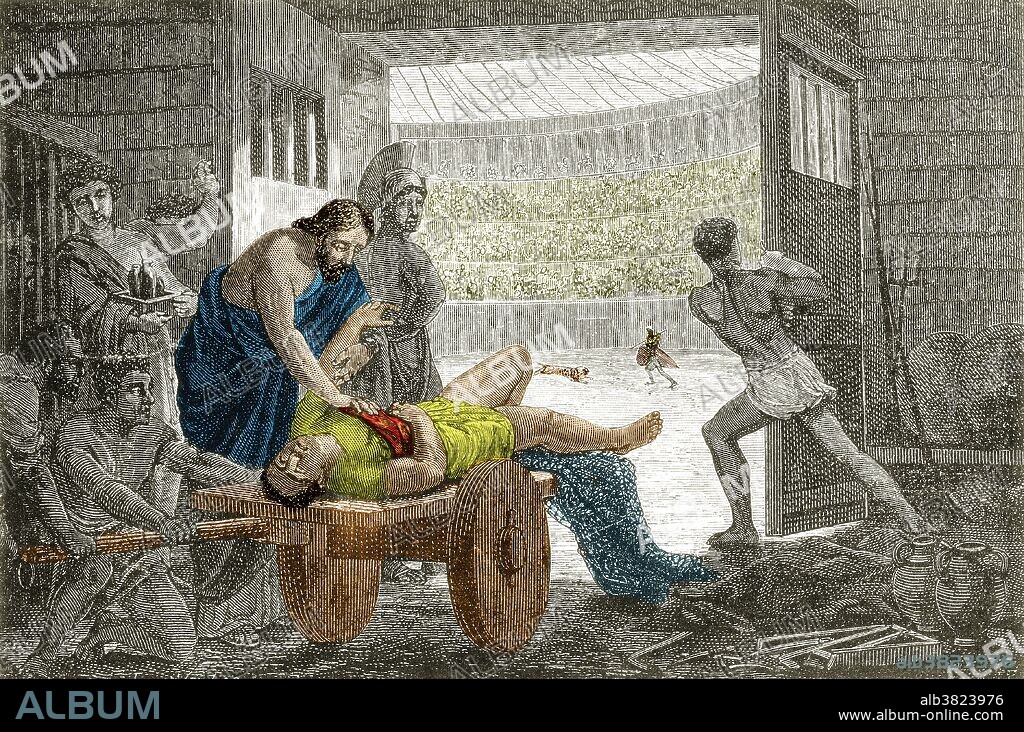alb3823976
Galen Treating Gladiator

|
Add to another lightbox |
|
Add to another lightbox |



Title:
Galen Treating Gladiator
Caption:
Galen (131-201) was born in Asia Minor. After receiving medical training in Smyrna and Alexandria, he gained fame as a surgeon to the gladiators of Pergamos. He was summoned to Rome to be the physician of the Emperor Marcus Aurelius and spent the rest of his life at the Court writing an enormous corpus of medical works. Taking Hippocrates' notions of the humors and pathology, he incorporated the anatomical knowledge of noted Alexandrians. A supporter of observation and reasoning, he was one of the first experimental physiologists, researching the function of the kidneys and the spinal cord in controlled experiments. His works came to symbolize Greek medicine to the medical scholars of Europe and the Middle East for the next 15 centuries. The most accomplished of all medical researchers of antiquity, he contributed greatly to the understanding of many scientific disciplines including anatomy, physiology, pathology, pharmacology, neurology, philosophy, and logic.
Credit:
Album / Science Source
Releases:
Model: No - Property: No
Rights questions?
Rights questions?
Image size:
4650 x 3082 px | 41.0 MB
Print size:
39.4 x 26.1 cm | 15.5 x 10.3 in (300 dpi)
Keywords:
2ND CENTURY • 3RD CENTURY • AELIUS GALENUS • AMPHITHEATER • AMPHITHEATRE • AMUSEMENT • ANATOMIST • ANCIENT • ANTIQUITY • ARENA • ARMED COMBATANT • ART • ARTWORK • CELEBRITY • CLASSICAL • CLAUDIUS GALENUS • COLOR • COLORIZED • CONTESTS • DIVERTISSEMENT • DRAWING • EMPEROR MARCUS AURELIUS • ENHANCE • ENHANCEMENT • ENTERTAINERS • ENTERTAINMENT • FAMOUS • FIGHTER • FIGURE • FORUM • GALEN OF PERGAMON • GALEN • GALENUS • GAMES • GLADIATOR • GLADIATORIAL • GREEK • HELMET • HISTORIC • HISTORICAL DOCTOR • HISTORICAL PHYSICIAN • HISTORICAL • HISTORY • ILLUSTRATION • ILLUSTRATIONS • IMPORTANT • MALE • MAN • MARCUS AURELIUS ANTONINUS • MARCUS AURELIUS • MARTIAL ARTS • MARTIAL ETHICS • MEDICAL • MEDICINAL • MEDICINE • MEN • NOTABLE • OBSERVATION AND REASONING • PATHOLOGIST • PEOPLE • PERSON • PERSONALITIES • PERSONALITY • PHILOSOPHER • PHYSIOLOGIST • POLYMATH • SCIENCE • SHIELD • SOCIAL LIFE • SURGEON • SWORD • SWORDSMAN • TREATING • TREATMENT • WELL-KNOWN • WESTERN PHILOSOPHY • WOUND
 Pinterest
Pinterest Twitter
Twitter Facebook
Facebook Copy link
Copy link Email
Email

